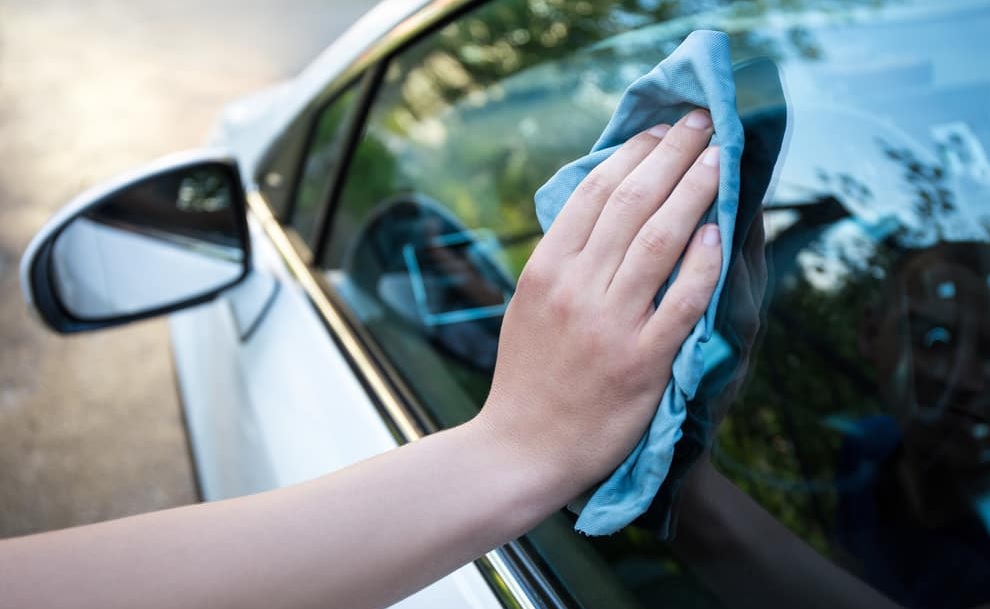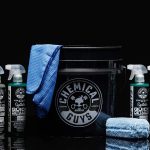Picture this: you’ve just returned from a long road trip, and your car wears the remnants of the journey in the form of dirt, bugs, and perhaps a splash of mystery substance. As you stand before your trusty vehicle, armed with a cleaning cloth and a bottle of Windex, a question pops into your mind – can you use Windex on car paint without causing harm? In the realm of car care, misinformation abounds, and it’s time to separate the car care myths from the facts.
Understanding the Windex Conundrum
Is Windex Safe for Car Paint?
The journey into answering this question begins with a closer look at the contents of Windex. As many of us know, this household glass cleaner has been a reliable ally in battling grime on various surfaces. However, when it comes to your car’s delicate paint, the stakes are higher, and the ingredients in Windex demand scrutiny.
1. Decoding Windex Ingredients
Windex typically contains a concoction of cleaning agents, water, fragrances, and perhaps most importantly, ammonia. Ammonia is a double-edged sword. While effective in breaking down grime on glass surfaces, it poses a potential threat to your car’s paint.
2. The Perils of Ammonia
Ammonia, known for its strong cleaning properties, can also be an aggressor when it comes to automotive paint. Its harsh nature raises concerns about long-term damage, including fading and deterioration. The chemical reaction between ammonia and certain paint finishes could lead to a lackluster appearance over time.
3. Alternatives to Windex
The verdict on Windex’s safety might lean towards caution, but fear not! There are plenty of car-friendly alternatives that can keep your vehicle gleaming without risking harm to its exterior.
Consider waterless car wash solutions, specifically formulated for automotive surfaces. These products often offer a safer alternative to traditional household cleaners, ensuring your car remains blemish-free.
Best Practices for Car Paint Maintenance
4. Gentle Cleaning Techniques
The journey to preserving your car’s paint isn’t just about the cleaning agent—it’s about how you use it. Adopting gentle cleaning techniques is paramount. Opt for a two-bucket wash method, using one bucket for soapy water and another for rinsing your wash mitt. This prevents grit from finding its way back to your vehicle’s surface.
5. Choosing the Right Cleaning Products
The market is flooded with a plethora of car cleaning products, each promising a showroom shine. Selecting the right ones can be overwhelming but pivotal in preserving your car’s aesthetics. Look for pH-neutral soaps and waxes designed explicitly for automotive use.
6. The Role of Microfiber Towels
Enter the unsung heroes of car cleaning—microfiber towels. These soft, lint-free wonders are your paint’s best friend. Unlike rougher materials, microfiber towels reduce the risk of scratches and swirl marks during the cleaning process.
Addressing Common Concerns
7. Myth vs. Reality: Windex Edition
Let’s debunk some myths surrounding Windex and car paint. One prevalent misconception is that Windex enhances the shine of your car’s paint. In reality, the ammonia content can do more harm than good, compromising the long-term luster of your vehicle.
8. Can Windex Enhance Paint Shine?
The desire for a glossy finish is understandable, but relying on Windex to achieve it might be wishful thinking. There are dedicated automotive detailing products designed to enhance paint shine without the risks associated with household cleaners. (See Also: Does Clay Bar Damage Clear Coat? Expert Insights and Tips)
Expert Tips: Safeguarding Your Car’s Paint with Precision
Embarking on the journey of maintaining your car’s paint is more than a routine chore; it’s an investment in the longevity and aesthetic appeal of your vehicle. To master the art of car care, consider these expert tips that go beyond the basics, providing a meticulous approach to preserving your car’s showroom shine.
1. Mind the Wash Frequency
Washing your car is a delicate balance. While cleanliness is crucial, overwashing can be detrimental. Aim for a regular schedule, typically once a week, but adjust based on environmental factors. Be mindful of the cleaning products you use, opting for pH-neutral options to prevent stripping away protective layers.
2. Invest in Quality Car Covers
Your car’s exterior faces a barrage of elements daily. Investing in a high-quality car cover serves as a shield against UV rays, bird droppings, tree sap, and harsh weather conditions. This preventive measure not only protects your paint but also maintains the resale value of your vehicle.
3. Wax Wisely and Regularly
Selecting the right car wax is pivotal for paint protection. Quality wax not only enhances the shine but forms a crucial barrier against contaminants. Regular waxing, every three to six months, ensures a resilient shield that fights off environmental hazards, keeping your car looking as good as new.
4. Avoid Automated Car Washes with Brushes
While convenience is tempting, automated car washes with abrasive brushes can leave fine scratches on your car’s surface. Opt for touchless or handwashing methods to maintain the integrity of your paint, ensuring a scratch-free finish.
5. Mind the Drying Process
After a meticulous wash, the drying process is equally critical. Resist the temptation to let your car air dry, as this can lead to unsightly water spots. Instead, use a clean, soft microfiber towel to gently pat your car dry, minimizing the risk of swirl marks and maintaining a pristine finish.
6. Tackle Bird Droppings Promptly
Nature’s calling cards—bird droppings—contain acidic elements that can swiftly damage your car’s paint. Address them promptly using a gentle cleaning solution and a soft cloth to prevent lasting harm. The key is swift action to minimize potential damage.
7. Be Mindful of Parking Spots
Strategic parking can significantly impact your paint’s longevity. Opt for shaded areas whenever possible to shield your car from the harsh effects of direct sunlight. If covered parking isn’t available, consider investing in a windshield sunshade to protect both your interior and exterior.
8. Inspect and Address Paint Chips
Regularly inspect your car for paint chips and scratches, addressing them promptly. Use high-quality touch-up paint matched to your vehicle’s color to prevent corrosion and further damage. This proactive approach ensures your car remains free from blemishes.
9. Utilize a Clay Bar Periodically
Incorporating a clay bar into your detailing routine every six months can work wonders for your car’s paint. This specialized tool effectively removes embedded contaminants, providing a smooth and pristine surface that enhances the overall appearance of your vehicle. (See Also: How To Remove Touch Up Paint From Car: Expert Tips for Flawless Results)
10. Consider Professional Detailing Services
While DIY care is essential, occasionally entrusting your car to professional detailing services offers a deeper level of care. Detailing experts have the tools and expertise to address specific paint concerns, ensuring a thorough and meticulous restoration of your car’s brilliance.
Incorporating these expert tips into your car care routine elevates the process from a mundane task to a precision art. As you implement these practices, watch your vehicle transform into a testament to the art of meticulous maintenance, standing out with a radiant and enduring allure on every road it travels.
FAQs: Navigating the Intricacies of Car Paint Care
As guardians of our cherished vehicles, questions about the best practices for caring for car paint often arise. To provide clarity on the nuances of maintaining that pristine shine, here are some frequently asked questions with expert answers to guide you through the intricacies of car paint care.
1. Is it Safe to Use Windex on Car Paint?
Answer: While Windex is effective on glass, it’s not recommended for car paint. The ammonia content can be harsh, potentially leading to long-term damage such as fading and deterioration.
2. How Often Should I Wax My Car?
Answer: A general rule is to wax your car every three to six months. However, factors like climate, usage, and the quality of wax used can influence the frequency. Regular waxing provides a protective layer against environmental contaminants.
3. Can Bird Droppings Really Damage Car Paint?
Answer: Yes, bird droppings contain acids that can swiftly damage car paint. Promptly clean affected areas with a gentle solution and cloth to prevent lasting harm.
4. Are Automated Car Washes Safe for Paint?
Answer: Automated car washes with brushes can cause fine scratches on your car’s paint. It’s advisable to opt for touchless or handwashing methods to ensure a scratch-free finish.
5. How Do I Address Paint Chips and Scratches?
Answer: Regularly inspect your car for paint chips and scratches. Address them promptly using high-quality touch-up paint matched to your vehicle’s color to prevent corrosion and further damage.
6. Do I Need a Car Cover if I Have a Garage?
Answer: While a garage provides protection, a high-quality car cover adds an extra layer, safeguarding your vehicle from UV rays, bird droppings, and other environmental elements, especially if parking outdoors. (See Also: Meguiars Ultimate Compound vs M105: Unveiling the Best Auto Polishing Solutions)
7. Can I Wash My Car Too Often?
Answer: Yes, overwashing can be as harmful as neglect. Aim for a regular washing schedule, usually once a week, but adjust based on environmental factors. Use pH-neutral cleaning products to prevent stripping away protective layers.
8. How Do I Choose the Right Car Wax?
Answer: Select a high-quality car wax designed for automotive use. Consider factors like the type of finish on your car, application ease, and durability. Regular waxing enhances the shine and protects the paint.
9. Is a Clay Bar Necessary for Regular Maintenance?
Answer: While not required for every wash, using a clay bar every six months can effectively remove embedded contaminants, providing a smooth and pristine surface for an enhanced appearance.
10. What’s the Best Drying Method After Washing?
Answer: Resist air drying to prevent water spots and use a clean, soft microfiber towel to gently pat your car dry. This minimizes the risk of swirl marks and maintains a pristine finish.
Navigating the world of car paint care involves addressing common questions with informed answers. As you embark on your car care journey, these FAQs aim to provide the guidance needed to keep your vehicle’s paint in impeccable condition.
Conclusion: Navigating the Car Care Maze
As we navigate the maze of car care, armed with knowledge about ingredients, alternatives, and best practices, it’s evident that the choice between Windex and your car’s paint requires careful consideration. Your car, with its gleaming exterior, deserves the best care you can provide.
So, can you use Windex on car paint? The answer, it seems, involves understanding the nuances and making informed choices. Your journey to maintaining a radiant vehicle is not just about the destination; it’s about the care you invest along the way. As you embark on this car care adventure, may your vehicle continue to shine for miles and memories to come.



